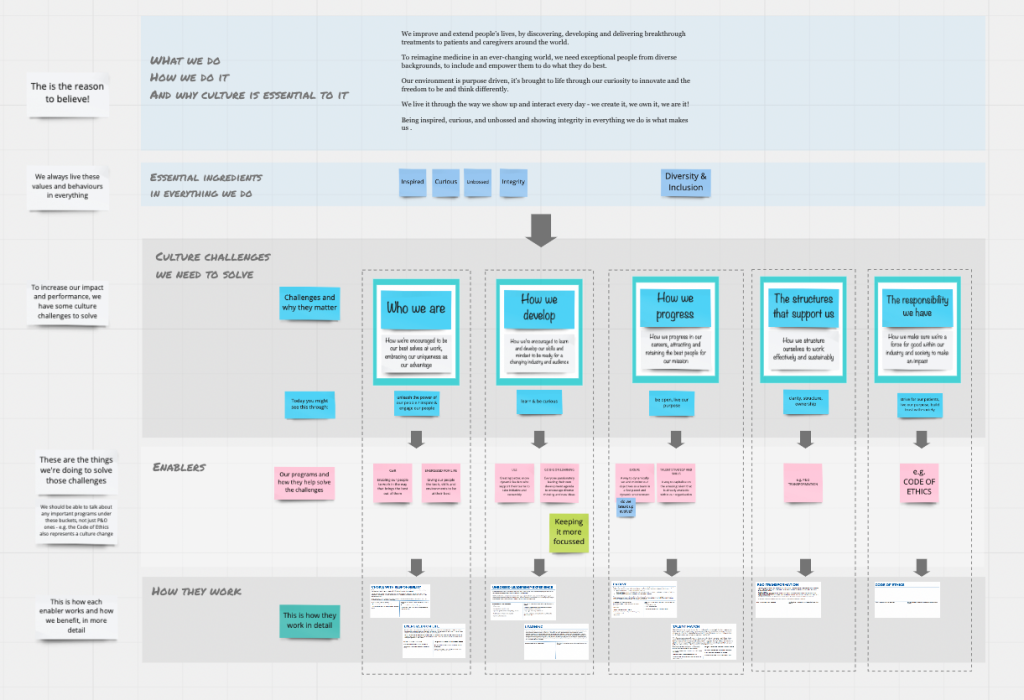Growing up, did you read a version of ‘Stone soup’? It’s a European folk tale about a traveller getting villagers to contribute their resources to a communal stew, meaning everyone gets more than they would from their individual item.
Its message is that co-ordinating and combining resources leads to something ultimately richer and more fulfilling than your single resource alone.
It’s the same within organisations and their efforts to level up their culture and performance. The whole is more than the sum of its parts.
Culture isn’t one thing or a single initiative. And given it’s well established that culture drives performance, how do you create a culture that delivers?
Like the ingredients of the stone soup, organisations are made up of many parts, each of which need to be pulling together in the same direction with common values, goals and behaviours, and it’s this unified purpose that enables a strong culture.
Empowering teams to explore, develop and grow new initiatives is the first step in creating a performance culture. But whilst it’s all very well having lots of great initiatives, if they’re unco-ordinated, siloed, and not driven by a clear link back to purpose, individuals feel detached from the culture and lose motivation, and the organisation can’t communicate the value of these initiatives back to the wider business.
As with your soup ingredients, you need to bring together all the elements and make sense of them. Both how they individually connect to the company purpose, and demonstrate their combined power as a whole.
When we started to work with our client, they broadly knew they needed to reestablish the link between culture and performance, and had started to empower their teams to do the work. There were a series of culture initiatives in place, and some that we had had the privilege to work with them on, including a new performance management approach, flexible working and more
But there was a disconnect. Each initiative existed in isolation, with the link back to overall company culture and how it would improve company performance left unclear: Why are we doing this? How does it fit into the bigger picture?
Our work was to make sense of the initiatives together, how they interconnected, linked back up to the bigger corporate purpose and mission, and ultimately show how they made a better organisation. We needed to make sure all the efforts were having the right cumulative effect, pushing in the right direction to amplify and supercharge the company’s work.
Why?
- It breaks down silos
- It amplifies the effects by modelling new behaviours, supporting a culture of ownership and empowerment, and sharing learnings across teams.
- It contributes back into the culture, and creates a virtuous circle, encouraging and empowering others and driving real value
To make this happen, all the initiatives needed to go into the proverbial soup cauldron, and we needed to show how the combined effect added value and created something amazing.
So how might you start to do this yourself?
Organise. With purpose.
- Clarify – your company’s purpose, mission statement and values
- Streamline – define each piece of work, it’s benefits, and how it links back to your purpose
- Create a map/framework – so everyone can see and understand how the pieces connect and support each other
- Communicate – articulate and share story of the framework with the wider organisation
Our client already had a good foundation with their permissive culture and the objective was not to start more initiatives at this stage, but better understand, connect and use the ones that were already happening. so we started organising:
Making sense – what we did
- We streamlined. Again and again. We found the pieces that fit together, clarified how they supported the company purpose and consolidated them around six core pillars
- We made a map so we could see the wood for the trees, This formed a comms framework to visualise how all the initiatives supported the organisation, it’s purpose and culture, as well as how to communicate their relation to performance
- We created resources to help communicators have better conversations with individuals, by understanding whether they were a culture skeptic, neutral, or advocate
From this:

To this:

And finally to this:

Throughout all this, we worked most closely with the comms team – after all, they were responsible for talking about culture – to launch the initiative.
We also addressed how to have conversations around culture, and the various initiatives with a range of people. To do that, we created a sheet to walk through with employees.
The team demo’d the new culture map, as well as the comms framework to their peers. Feedback was fantastic, with many feeling they finally had a resource to help them clearly articulate how the cultural initiatives connected and ultimately benefited the company.
The framework and map were rolled out more widely, and have been informing culture communications since.
And here’s how you can do it…
If you’re keen to try and map your landscape of cultural enablers, you can download the framework here. Start from the top, and work through layer by layer.
And if you’d like more detail about how to use this tool, or if you’re unsure where to start, let’s talk.
